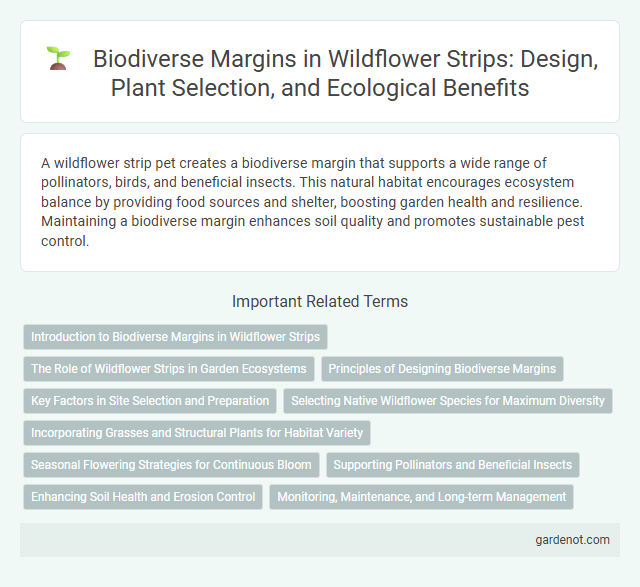A wildflower strip pet creates a biodiverse margin that supports a wide range of pollinators, birds, and beneficial insects. This natural habitat encourages ecosystem balance by providing food sources and shelter, boosting garden health and resilience. Maintaining a biodiverse margin enhances soil quality and promotes sustainable pest control.
Introduction to Biodiverse Margins in Wildflower Strips
Biodiverse margins in wildflower strips create essential habitats that support a wide range of pollinators, beneficial insects, and native wildlife. These margins enhance ecosystem services such as pest control, soil health, and pollination, promoting sustainable agricultural practices. Integrating a diverse mix of native plant species in these areas increases resilience and biodiversity in agricultural landscapes.
The Role of Wildflower Strips in Garden Ecosystems
Wildflower strips serve as biodiverse margins that significantly enhance garden ecosystems by providing essential habitats for pollinators such as bees and butterflies. These strips increase plant diversity, support beneficial insects, and improve soil health through natural nutrient cycling. Incorporating wildflower strips promotes ecological balance, leading to more resilient and productive garden environments.
Principles of Designing Biodiverse Margins
Designing biodiverse margins in wildflower strips emphasizes selecting native plant species that support local pollinators and wildlife, enhancing ecosystem resilience. Incorporating a variety of flowering plants with staggered bloom times ensures continuous food sources throughout seasons, promoting species diversity and habitat connectivity. Soil quality and microhabitats are carefully assessed to optimize plant health and encourage natural seed dispersal and germination within the margin.
Key Factors in Site Selection and Preparation
Selecting a site with ample sunlight, well-drained soil, and minimal competition from invasive species ensures optimal growth for wildflower strips. Soil pH between 6.0 and 7.5 supports diverse native plant species, while prior soil testing guides necessary amendments to enhance nutrient availability. Proper site preparation, including the removal of existing vegetation and light tilling, promotes seed-to-soil contact vital for seed germination and establishment.
Selecting Native Wildflower Species for Maximum Diversity
Selecting native wildflower species for a biodiverse margin enhances ecosystem resilience by supporting local pollinators and wildlife. Prioritizing a mix of perennial and annual species tailored to regional climate and soil conditions maximizes floral diversity and continuous bloom periods. Incorporating plants such as Echinacea purpurea, Solidago canadensis, and Asclepias tuberosa promotes habitat complexity and nutrient cycling within the wildflower strip.
Incorporating Grasses and Structural Plants for Habitat Variety
Biodiverse wildflower strips that incorporate grasses and structural plants create diverse habitats supporting a wide range of pollinators, insects, and small wildlife. Including species like tall grasses, sedges, and flowering perennials enhances structural complexity, promoting nesting sites and food resources throughout different seasons. This varied plant composition improves ecosystem resilience and encourages natural pest control by attracting beneficial predators.
Seasonal Flowering Strategies for Continuous Bloom
A biodiverse wildflower strip employs seasonal flowering strategies to ensure continuous bloom throughout the growing season, supporting pollinator populations and enhancing ecosystem resilience. Early spring blooms include species like crocus and lungwort, followed by mid-season flowers such as oxeye daisy and red clover, while late-season bloomers like goldenrod and asters extend floral resources into autumn. This temporal distribution of flowering periods maximizes habitat value and promotes sustainable biodiversity in agricultural landscapes.
Supporting Pollinators and Beneficial Insects
Wildflower strips enhance biodiversity by providing essential habitats and nectar sources for pollinators such as bees, butterflies, and hoverflies, boosting their populations and activity. These biodiverse margins also support beneficial insects that contribute to natural pest control, reducing reliance on chemical pesticides. Implementing wildflower strips strengthens ecosystem resilience while promoting sustainable agricultural practices.
Enhancing Soil Health and Erosion Control
Establishing a wildflower strip as a biodiverse margin significantly improves soil health by increasing organic matter and microbial activity, which enhances nutrient cycling and soil structure. Deep-rooted flowering plants stabilize the soil, effectively reducing erosion and runoff during heavy rainfall. This natural erosion control combined with enhanced soil vitality promotes sustainable land management and supports ecosystem resilience.
Monitoring, Maintenance, and Long-term Management
Effective monitoring of a wildflower strip involves regular assessments of plant species diversity, invasive weed presence, and pollinator activity to ensure ecological balance. Maintenance practices include selective weeding, periodic mowing, and reseeding native plants to sustain habitat quality and promote biodiversity. Long-term management integrates adaptive strategies based on monitoring data to enhance ecosystem resilience and support continuous growth of native flora and fauna.
Biodiverse margin Infographic

 gardenot.com
gardenot.com